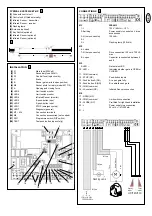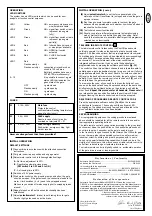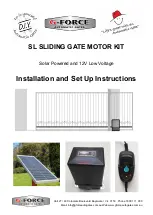
GB-2
INSTALLATION OF DRIVE BASE PLATE -
The base plate for the drive can either be concreted in or, if appropriate,
welded into position. The place where the base plate is usually located
is shown on the installation overview. The concrete plinth needs to be of
an appropriate size (approx. 50cm x 50cm x 50cm).
Please note:
If it is impossible to precisely determine the height of
the plinth and the distance from the gate prior to installation, it is
advisable to mount the rack bars first and then concrete in the base
plate. Spacers are fitted to move the rack bars approx. 40mm
towards the inside.
The distance from the bottom edge of the rack bar to the base plate
is approx. 8 - 9cm. The base plate permits final height and depth
adjustments of several centimetres to be made, but you are advised
to work as precisely as possible from the outset.
MOUNTING MOTOR AND GEAR UNIT
The drive should be fitted on to the threaded bolts in the base plate.
The height should be set such that there is a gap of approx. 1 - 2mm
between the cog wheel and the rack bar. The weight of the gate should
not be borne by the cog wheel! Position the drive via the adjustment
holes such that its location vis-à-vis the rack bar complies with the
installation dimensions.
MOUNTING RACK BAR
The easiest way to fit the rack bar is to first place it on the motor's
drive cog, disengage the motor and, by pushing the gate further with
the rack bar, screwing the bar bit by bit firmly in position. In this way,
you ensure that the rail bar engages with the cog wheel in an optimum
manner. While doing this, do not forget to mark each fixing point.
DRIVE RELEASE MECHANISM (MANUAL OPERATION)
The drive is equipped with a lockable release mechanism to enable
the gate to be operated manually in a power cut. The release
mechanism is shown in
fig. 7
with the clutch disengaging the link
between the cog wheel and the gear.
To release the drive:
Position the socket spanner appropriately and
turn it 180 degrees. Then turn the release lever 180 degrees too.
Finished.
FITTING LIMIT SWITCHES (TO GATE)
The limit switches are assembled as shown in
fig. 8
.
One limit switch magnet is designated A (1) and the other B (2).
Fit the limit switches on to the rack bar in those places where the
final travel positions are roughly expected to be. The magnet should
point towards the motor. The switch (contact) is located in the middle
of the motor. Screw the retaining clip only provisionally in place or
slot it lightly on to the rack bar.
Limit switch A (1) for gate closed; limit switch B (2) for gate
open.
TESTING LIMIT SWITCH FUNCTIONALITY (LIFTMASTER
CONTROL)
Disengage the gate and operate it only using your hands. Push the
gate into the respective final travel positions. The control unit should
already have been connected up.
On the control unit there are two red LEDs (LED 5 & LED 6) that go
out when the magnet on the gate trips the given switch. One LED is
for limit switch OPEN (LED 5) and the other for CLOSED (LED 6).
When you open the gate manually, the correct LED should go out. If
the wrong LED goes out, you need to swap limit switches A (1) and
B (2) around. Alternatively, the limit switch cables connected to the
control unit (17 + 19) can be swapped around. The distance between
the limit switch magnet and the switch on the drive should be as small
as possible. Under no circumstances should it be more than 25mm.
Important: If the limit switches have been swapped around, the gate
will open and not close after the set pause when in programme
selection (automatic) mode!
Caution: A sliding gate must run in a guide rail and should not
be able to leave the rail. This means end stops need to be fitted
for both directions!
BEFORE YOU BEGIN
There are many factors that are key to the choice of the right
sliding gate drive.
Assuming the gate is in good working order, the
most difficult aspect is getting the gate to move. Once the gate is in
motion, force requirements are in the main significantly reduced.
• Gate size:
Gate size is a very important factor. A light yet long
gate (long = + 5m) needs a far greater force to set it in motion
than a short, heavy gate does.
WIND CAN BRAKE A GATE'S MOVEMENT OR MAKE IT HARD
TO MOVE, THUS INCREASING FORCE REQUIREMENTS
SIGNIFICANTLY.
• Gate weight:
Gate weight is only an approximate indicator the
actual relevance of which can vary greatly.
Example: A light gate
that slides poorly is likely to need a stronger drive than a
heavy, smooth-sliding gate.
• Temperature:
Low outdoor temperatures make it difficult or, in
some cases, impossible to get the gate moving due, for instance,
to changes in the ground conditions. In such cases, a stronger
drive again might be necessary. High outdoor temperatures can
cause the thermal protection mechanism to be activated sooner.
• Operating frequency / Duty cycle:
Sliding gate drives have a
maximum duty cycle of approx. 30% (e.g. 30% per hour).
CAUTION:
The drives were not designed to be run for the maximum duty cycle
on a regular basis (permanent operation). If the drive gets too hot, it
switches itself off until it has cooled down to activation temperature.
The outdoor temperature and the gate itself are key factors
determining the drive's actual duty cycle
• Safety:
A sliding gate drive has to be fitted with a flashing lamp,
contact strips and, if necessary, with additional light barriers as safety
features. Please ensure that you comply with the standards and
regulations relevant to your particular case.
• Control unit:
The control unit was developed specifically with
safety aspects in mind.
It is already located under the drive hood
and wired up for right-hand installation as standard (motor to the
right of the gate). See figs. 2 - 3.
CHECK LIST - PRE-INSTALLATION WORK -
Prior to actual installation, please check that you have been provided
with all the parts indicated within the scope of supply.
Make sure your gate system is in good working order.
The gate must run smoothly, not jerkily and not make contact with
the ground at any point. Bear in mind that the ground can be several
centimetres higher in winter. The gate needs to be stable with as little
play as possible to prevent any lateral movement from occurring. The
easier the gate moves, the more sensitive the force setting needs to
be.
Make a note of the materials you still need and make sure you obtain
them prior to installation - adhesive anchors (strong plugs), screws,
stops, cable, distributor boxes, tools, etc.
OVERVIEW OF INSTALLATION
A general overview of installation can be found on the front sheet of
these instructions. The drive has to be installed behind the wall to
ensure that no part of it projects out into the gate opening. The motor
has to be mounted on the flush fitted base plate. The rack bar shown
has to be fitted to the gate with the fixing material supplied.
Decide which is the best height for fixing the rack bar to the gate and
use this to determine the installation dimensions for the motor unit
and base plate. Should the gate be unsuitable for fitting the rack bar
to it, a fixing profile (angle bracket, shaped tubing, etc.) needs to be
mounted first.
A
C
5
6 A
4
7
8
























